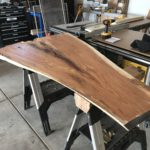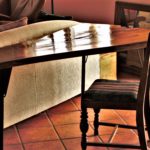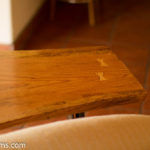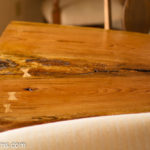Recently, I set up a “jig” to flatten or plane large slabs of wood previously cut on the portable sawmill. The jig features a 2″ x 12″ micro-lam or LVL beam ripped in half the long way. The beam was a friend Rich’s idea and provides a super stable, level set of rails over which pass another jig built to house the heavy duty 3 hp. router that will flatten the slab. Of course, there are a couple of regular pine 2×6’s used as spreaders to keep the rails at a prescribed distance apart. Several passes are usually required to get the slab flat as drying has caused a bit of deformation in the surface (sometimes up to 1/2″ as you look across the surface of the slab) . And, I only cut about 3/16″ on each pass to avoid overloading the router motor. Shop-vac is connected to the router jig with a floor sweep attachment which picks up most of the sawdust as the jig is moved from one end to the other and back and forth across the slab. The slab is supported on the floor by shims that put the slab in a more or less neutral position so that I’m not cutting a bunch off one corner to level it. I make a few passes on the “bottom” side of the table to get a flat surface and then flip the slab and make the “top” flat. Most of the care and time are dedicated to the top as that will be the side everyone sees.
I like to sand both sides. I once read that, “whatever you do to the top, do to the bottom”. The idea is that differences in finishing the two sides may cause differential drying, cracking or other movement that will affect the piece in the long term. It’s extra work but it is a nice when you run your hand under the table and feel a nice, finished surface.
The first picture shows the slab in the jig and the second shows the slab after sanding with a bit of water wiped on to show the grain. Generally, I’ll wet the slab between rounds of sanding to raise the grain and allow it to be sanded down to super nice finish. The red oak “crotch”, where the branch splits into two smaller branches contains some spectacular grain and figure. This slab was no exception.
The last three pictures below are after cutting in butterflies into some of the cracks in the slab and finishing the top with tung oil.





